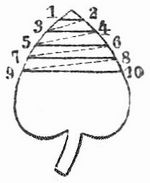Satin stitch
The satin stitch is a fill stitch used in embroidery. The stitch is common on most hand embroidery machines , which is why they are sometimes referred to as satin stitch machines. The embroidery base (the fabric) is underlaid with large pre-stitches, the threads are placed close together on the upper side, so that a closed pattern is created. It creates a relief-like surface. The figure to be embroidered is determined during machine embroidery on the basis of the sample sheet, which the hand embroiderer follows on the pantograph.
In contrast to the cross stitch , the satin stitch is not tied to a square divisible base material that composes the pattern like a mosaic; it can be embroidered on any fabric or even leather. If hand-embroidered satin stitch patterns are shaded by lighter and darker graded yarns, one speaks of needle painting.
The original satin stitch is done with one thread, but modern schiffli machines use the two-thread schiffli technique instead of the actual satin stitch for the same purpose. The two-thread technique has two significant advantages: it can be carried out with threads of almost any length, while the single-thread hand embroidery machine according to Josua Heilmann can only process threads of about one meter in length. In addition, it is significantly faster because the thread does not have to be pulled completely through the embroidery base every time. Only one thread is used in hand embroidery.
See also: types of seams
swell
- Article embroidery machine in Meyers Konversationslexikon from 1905
- Article Plattstich in Meyers Konversationslexikon from 1905
- Article Plattstich in the textile and fashion dictionary; Alfons Hofer; German specialist publisher; Frankfurt am Main; 7th edition 1997; ISBN 3-87150-518-8


